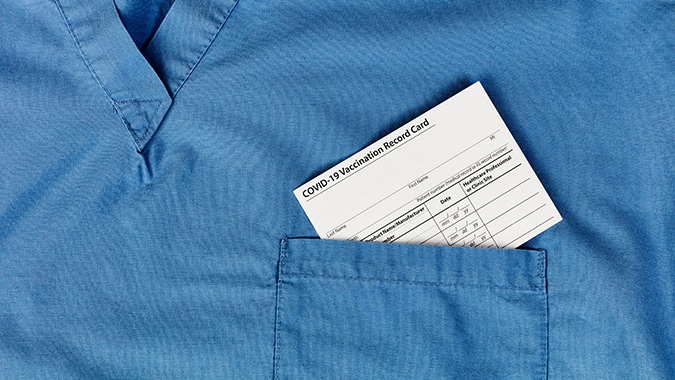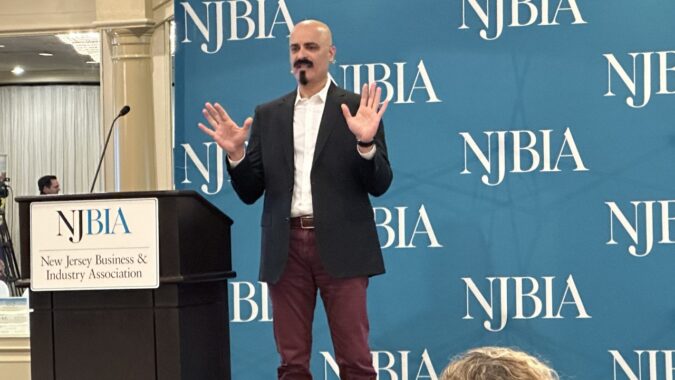 Two CEOs of healthcare and financial institutions who have successfully led their organizations during a pandemic that has upended business models discussed their greatest challenges, lessons learned, and the future of their industries during NJBIA’s “Inside the C-suite” webinar Monday.
Two CEOs of healthcare and financial institutions who have successfully led their organizations during a pandemic that has upended business models discussed their greatest challenges, lessons learned, and the future of their industries during NJBIA’s “Inside the C-suite” webinar Monday.
Gary Horan, CEO of Trinitas Regional Medical Center in Elizabeth, and Kevin Cummings, CEO of the Short Hills-based Investors Bank, told NJBIA President & CEO Michele Siekerka and Prager Metis CEO Glenn Friedman that the COVID-19 health and economic crisis have required their companies to pivot during a time of chaos and embrace organizational change to emerge stronger.
Horan said his hospital’s biggest challenge during the height of the crisis in April was obtaining personal protective equipment (PPE) when it was in short supply, but there were other difficulties as well. For example, the tenfold increase in patients requiring ventilators stressed the hospital’s oxygen supply system, causing distressing low-pressure alarm bells to ring throughout the medical center.
“The oxygen didn’t shut off, but it gave a low-pressure warning and it scared people,” Horan said. “So we were immediately able to get a hold of our oxygen supplier and they went into emergency mode and got us oxygen trucks to put into place while they expanded the oxygen system and that was all done within 24 to 25 hours,” Horan said.
The hospital had other logistical issues to deal with, including changing a same-day surgery unit into an intensive care unit to handle the influx of COVID-19 patients, Horan said. Although the hospital regularly holds disaster drills to prepare for emergencies, the creativity and teamwork the entire staff displayed adapting to the unique challenges of COVID-19 was incredible, he said.
Horan said the hospital has emerged from this ordeal stronger and in a better position to deal with a possible “second wave” of the pandemic. He predicted that long-term changes in the industry will include greater utilization of telemedicine, which many people used for the first time during the pandemic because they were unable to see their doctors in person.
For banks, it wasn’t PPE that was the challenge it was the PPP – the U.S. Small Business Administration’s Paycheck Protection Program, which inundated financial institutions with applications for low-interest business loans backed by the federal government. Normally, the SBA disperses about $35 billion in loans on annual basis, so the $650 billion PPP program was a substantial undertaking, Cummings said.
Following the release of the second round of PPP funding, Investors approved 1,900 small business loans impacting 35,000 jobs within 34 hours, Cummings said. “It was a mad dash because we didn’t know how much money was going to be there and how long it would last. And that made for some heated executive meetings… I think it was a great leadership lesson,” he said.
Cummings said when COVID-19 hit New Jersey in March, Investors realized that it would be necessary for many employees to work remotely. “We needed to go out and buy 750 laptops and send the whole corporate group home – and it was the best decision we could have made,” Cummings said.
Today, 25% of Investors employees are back in the office and another 25% are scheduled to return on July 6, Cummings said. He predicted one positive, long-term change resulting from COVID-19 crisis will be the willingness of more companies to allow employees to work remotely at least a few days a week.
“I think we have to be open to that and give people that opportunity to spend more time with their families by taking that 45-minute commute out of their schedule every day,” Cummings said.
Siekerka said COVID-19 has ushered in a sea of change, and New Jersey companies are having to reinvent themselves to adapt and survive.
“Change is difficult,” Cummings agreed, “but I think there’s going to be a lot of good that comes out of this. “We’re going to be a lot smarter on the healthcare side, on the business side and on the community side.”
To view the entire webinar, go here.




